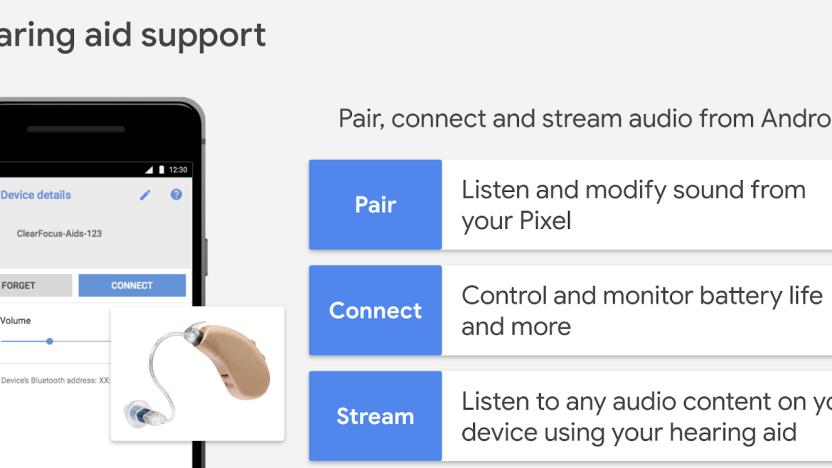hearingaids
Latest

Google brings native hearing aid support to Android
Accessibility is a critical consideration for manufacturers when they're building devices. Around 466 million people have disabling hearing loss, according to the World Health Organization, and that number is projected to grow to 900 million by 2050. Finding ways to help people who contend with hearing loss to get the most out of their devices is an important challenge for tech companies now and in the decades ahead.

Hearing aid uses your smartphone to target sound in a noisy room
Siemens has revealed new smart hearing aids that will definitely leave your grandpa's old model in the dust. The "wearable hearing tech" can automatically kill noise and let you control the microphone's direction with a smartphone to better pick up a voice in a noisy room. Siemens says the tech has been "clinically proven to outperform people with normal hearing in background noise." The system works with an Android or iOS "easyTek" app to help you better hear sounds in any direction, especially with two hearing aids. They can even act as a glorified Bluetooth headset for your smartphone, or operate independently without it. The exact prices and model numbers have yet to be revealed, but we're planning on giving them a try soon here at CES 2015 -- who doesn't want bionic hearing?

Apple seeks patent for hearing aids that deliver speech at an even keel
Although they're called hearing aids, they can sometimes be as much of a hindrance as a help. Catch an unfamiliar accent and the attention might be on just parsing the words, let alone moving the conversation forward. Apple is applying for a patent on a technique that would take the guesswork out of listening by smoothing out all the quirks. The proposed idea would convert speech to text and back, using the switch to remove any unusual pronunciation or too-quick talking before it reaches the listener's ear. Not surprisingly for a company that makes phones and tablets, the hearing aid wouldn't always have to do the heavy lifting, either: iOS devices could handle some of the on-the-fly conversion, and pre-recorded speech could receive advance treatment to speed up the process. We don't know if Apple plans to use its learning in any kind of shipping product, although it's undoubtedly been interested in the category before -- and its ambitions of having iPhone-optimized hearing aids could well get a lift from technology that promises real understanding, not just a boost in volume.

Accelerometer mic could change the way we look at cochlear implants
Hearing aids aren't the most discreet cybernetic creations, because the need for a clog-free microphone means that they generally need an external component. Engineers at the University of Utah and Case Western Reserve University in Cleveland aim to change everything with a much smaller mic that uses an accelerometer to detect sound vibrations -- so it requires no opening and can be inserted right into the ear. The only exterior hardware is the charger -- worn exclusively at night. Clinical trials in living humans begin approximately three years from now, and if you're looking forward to using this new device, removal of the incus (or anvil bone) in the middle-ear must first take place to optimize effectiveness of the new implant. We never said it'd be pretty.

Panasonic unveils new line of Bluetooth-enabled hearing aids
Hearing aids aren't the sexiest gadgets on Earth, but Panasonic has done some interesting stuff with its R1-W series of in-ear audio-boosters. For one, they come packing Bluetooth for directly tethering to a mobile or landline phone using the Hearing Hub and have an add-on audio transmitter than can beam content from a TV or other source directly to the aids. The Hearing Hub also has a voice memo feature so that wearers can take notes for themselves and play them back in an easy to hear format. All that and it manages a pretty impressive 300 hours on a single set of batteries. Check out the complete PR after the break.

Siemens pumps streaming audio to hearing aids with miniTek remote
See that tiny black box? It's a streaming audio hub, designed specifically for the hard of hearing who have Siemens earphones buried in their lobes. Connect special Tek transmitters to traditional TVs and stereos, or hook it up directly to a phone, audio player or PC over Bluetooth or 3.5mm jack, and the matchbox-sized, two-ounce remote will wirelessly stream stereo audio from two devices for up to five hours a time. (It's also apparently got an integrated coil for induction loop audio.) Just don't expect it to come cheap -- it's a medical product, you know. [Thanks, Klaus]

Oticon Epoq binaural Bluetooth headset doubles as hearing aid
Oticon's no alien to the niche world of overly useful hearing aids, and while it's been a few years since we've seen anything fresh from the company, its newest offering looks to help those aging ears deal with hearing loss while staying connected to modern technology. The Epoq lineup of "hearing instruments" allows a pair of Bluetooth earpieces to be worn simultaneously, and proprietary binaural high speed wireless technology allows the pair "to communicate at data transfer speeds 100 faster than hearing instruments now on the marker." In essence, the devices transmits "stereophonic auditory information that is in sync with a user's visual experience," and it also tries its hand(s) at being a Bluetooth headset that enables handsfree calling and music streaming when used with the "Streamer" add-on. Oticon will reportedly be rolling out the Epoq W (about $8,000) and Epoq XW (closer to $9,000) early next month.[Via Slashphone, photo courtesy of Stuff]





